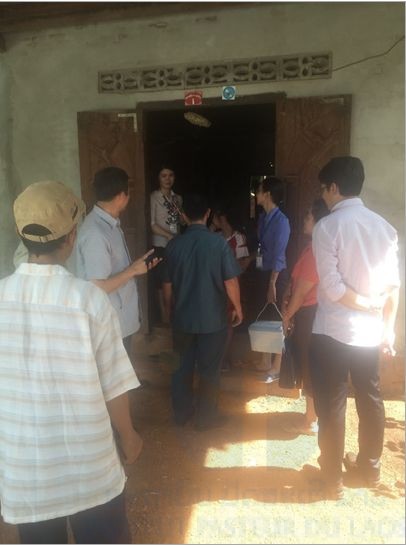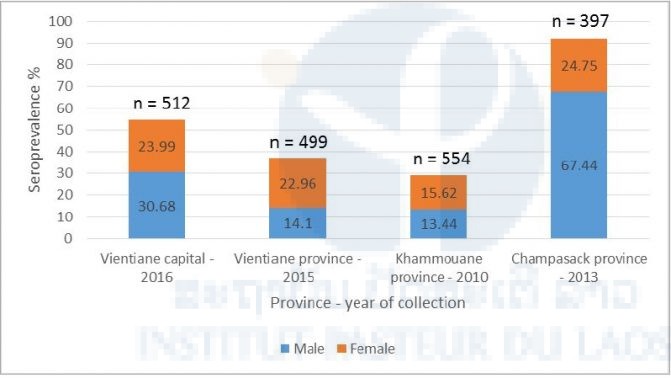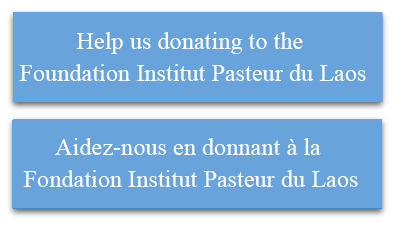Research and development
Project coordinator: Julie BOBICHON Member of
staff: Chintana LATHAPHASAVANG

Visited patient’s house with deputy of Xaythany district
Background:
A specific team was built in 2015 to focus on the development of ELISA tests for the detection of anti-arbovirus IgM and IgG adapted to local conditions. A first prototype for chikungunya virus IgM detection has been evaluated through a multicentric study (Valoexpress MACH-2). A panel of new tests has been set up to extend the diagnostic capacities of IPL and conduct seroprevalence studies. Selected viruses included yellow fever whose serious threat of emergence in South-East Asia has recently been raised by the importation of acute cases in Beijing in 2016.
Seroprevalence studies
Previous epidemiological studies of arbovirus transmission in the Lao PDR have indicated high levels of endemicity in both urban and rural communities; however, there have never been any investigations for a seroprevalence study on lesser-known arbovirus species. Moreover, the availability of serological testing remains a critical issue to face emerging arboviruses.
A collection of sera from a group of young patients (0-18 years) presented a fever rash syndrome was screened by ELISA for anti-Zika, anti-Chikungunya, anti-Phlebo, and anti-Tahyna IgG. The sero-positivity was high, up to 37.07 % for Tahyna virus, 29.85% for phlebovirus, 28.65% for Zika virus and 25.45% for Chikungunya virus, over 499 samples (Table 4).
Table 4: Seropositivity rates for anti-Zika, anti-Chikungunya, anti-Phlebovirus and anti-Tahyna antibodies of patients with fever rash symptoms.

According to these results, a collection of sera collected from groups of the Lao population living in the geographic area from which the phleboviruses were isolated was screened by ELISA to detect anti-Phlebovirus and anti-Tahyna IgG. Samples were collected in 2007 and 2010 in different villages of the Nakai plateau. The overall prevalence of phlebovirus reactive antibodies and Tahyna virus was 49.78% (472) and 30.45% (578) respectively in 2007, and 59.4% (372) and 29.06% (554) respectively in 2010 (Table 5).
Table 5: Seroprevalence of anti-Tahyna and anti-Phlebovirus antibodies of sera collected in Nakai plateau in 2007 and 2010

The isolation of Tahyna virus from three provinces in China suggests that this virus may be widely distributed across the Asia continent. Furthermore, previous results have shown a high percentage of seropositivity to Tahyna virus. To enlarge our study, we have therefore selected two populations: (i) 512 sera from patients with dengue fever symptoms from Vientiane collected in 2016 (ii) 397 samples from Champasack collected in 2013 from suspected cases of Chikungunya. A total of 54.68% (512) and 92.2% (397) respectively were found positive and present the highest rate of seropositivity in comparison with other populations (Figure n°7).
Figure n°7: Prevalence of anti-Tahyna virus antibodies in different provinces of Lao PDR

Figure 7. Seroprevalence of anti-Tahyna virus antibodies for Khammouane province (2007), Khammouane province (2010), Vientiane province, Champasack province, Vientiane Capital
The serological response to arboviruses for these populations shows the importance of continued surveillance activities.
Further studies are now ongoing to control the specificity of the antibodies detected by means of neutralization tests using prototype strains.
Support activities
The A&EVD laboratory supported different institutes within the Pasteur network. Table 6 summarizes biological material transfers in 2015.
Table 6: Biological material transfer activity, 2015–2016

Education activities
- Information on dengue surveillance and rapid diagnostic tests: Attapeu Provincial Hospital, Saravanh Provincial Hospital (6 days, August 2015).
- Dengue virus diagnosis: Training sessions for staff and students in Vientiane Capital hospitals (Mitthapad; 5 April; Setthathirat; Children’s Hospital: half a day per hospital).
- Diagnostic de la dengue/infection à virus chikungunya: Institut de la Francophonie pour la Médecine Tropicale (half a day, December 2015).






